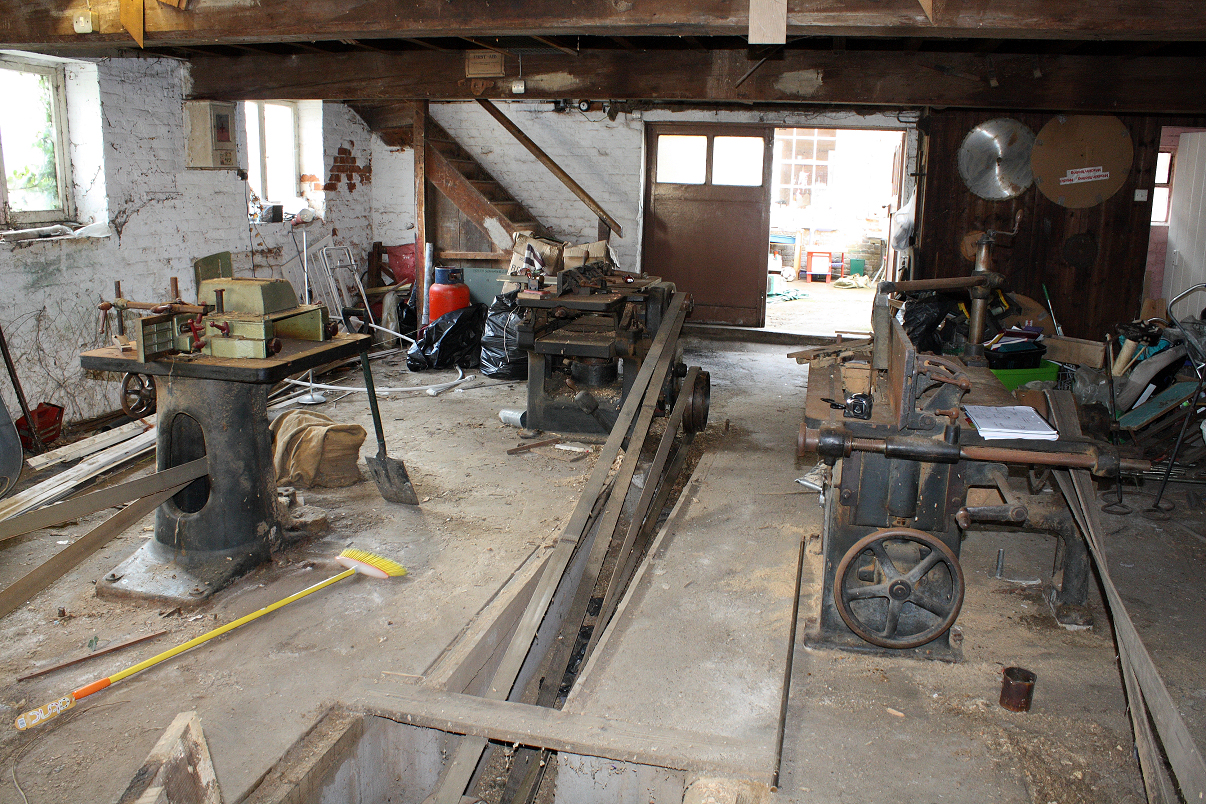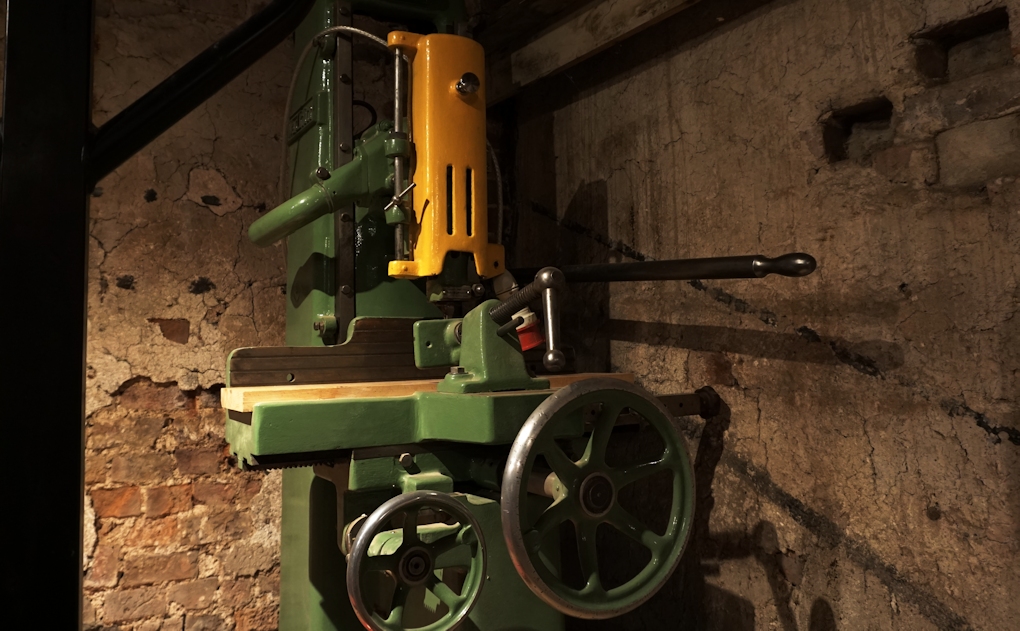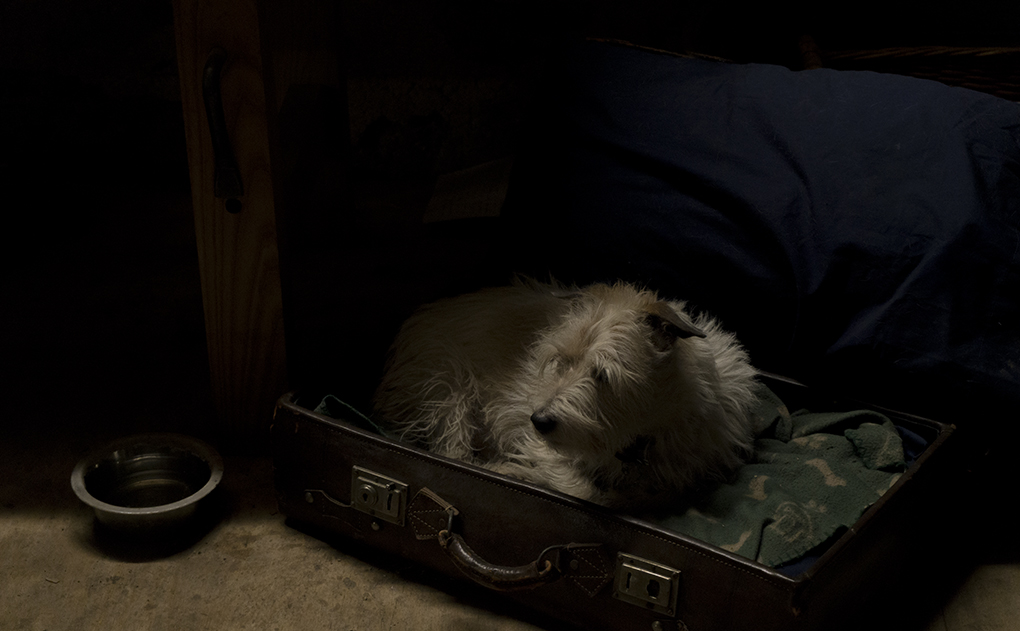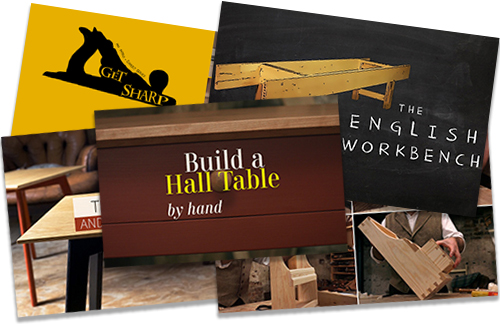Since completing work on the Wadkin cross cut saw we’re beginning to wonder how we ever got by making workbenches without it. Despite it’s age it’s got to be the most dependable machine that we’ve ever owned and whatever we throw at it gets cut fast, clean and accurately every time. Besides the tenoner though the remainder of the Wadkin workshop is belt driven so whilst we know they’re all going to be equally as good as the cross cut there’s a far greater journey to go on before these are back in action.
Before we can make plans to set up the line shaft we have to be sure that we’re in the right location. Our current workshop is rented but does have the height required should we decide to install the shaft overhead (its original location was under the floor). Making such alterations to some else’s building feels like it could be a bad move though and besides this as the business gets busier year on year it’s likely we’ll have to think about moving at some point down the line to obtain more space and consider the possibility of taking on an employee.
It must be normal for a small business to get growing pains at some point and have to make difficult decisions about growing bigger and better or keeping everything manageable and familiar. When you’ve always been small and depended only on yourselves the possibility of having to look elsewhere for advice and support does seem all the more daunting. Our lives and business often merge in to one and we’ve always done things against the grain rather than finding the more obvious and easy route. Wild ideas are usually whirling around in our heads but we’d like to think we’re grounded and reserved enough to take things one step at a time so whilst it may seem a little crazy on the outside we will actually have thought through all angles and feel confident before charging forward.
Current crazy ideas:
- Buy 100 year old Wadkin line shaft machinery
- Buy the perfect barn to install newly restored line shaft machinery
- Open workshop to the public for living history days
- Continue building the finest traditional workbenches
We’ve kept the list short so you don’t get too perplexed – we could have gone on but then you might have thought we were just being silly.
Though the line shaft is still a fair way off we do plan to restore the machines themselves whenever time allows. Of course all of these plans require a great deal of money so we have had to make smaller plans that will help to get things in motion. We would certainly never bring out a charity box and start shaking but we are going to be adding a shop to the blog very soon. Apologies in advance if this seems a little commercial but we will keep it separate from the usual posts and we definitely won’t be selling any tat! There’s also a much larger plan to be put in to play but we’re keeping that one close to our chests for the time being.
Richard & Helen







Richard
Have you given thought to keeping the line shaft under?
Raise floor and provide channels for the belts to run under rather than install overhead and have to alter machines to suit.
Just a thought as you are thinking out of the box.
Laurence
Hi Laurence,
That’s certainly up for debate and may well be a possible route to take. The main reason that we were thinking over head is because it will be more visable for people to see the workings and the machines are compatible for either positioning. If we were to keep the shaft below the machines then your suggestion of raising the floor makes a lot of sense rather than digging down.
Thanks, Richard
Richard
The decision making process is inevitably complicated by legal issues, which ought to be considered, well in advance, however boring that may sound.
The cost of the line shaft installation has to be thought of, in the context of the terms and length of your existing lease, business plan and the timescale within which your business plan might indicate a move to larger premises would become a necessity.
As a self employed development surveyor, we spent 10 years in rented accomodation, then bought our own freehold office, as an investment, with a business mortgage. The equipment issue was not a problem as it is for you, but would be worth considering as the interest on the mortgage can be set off against tax.
I can’t see where you are located, but it might be worth looking at the local workshop market to get some ideas as to what is available and what rental and freehold levels are like in your area.
As a very sweeping generalisation, commercial values are at a very much lower level than they were 5 or so years ago, but against that, business funding from banks etc, are very much harder to obtain.
However, market conditions where you are may give you leverage to negotiate rent free periods and better and longer lease terms as commercial landlords still have to pay council tax, in most cases, whether they are empty or not, encouraging owners to secure a letting even if in the short term, they only offset that cost, or obtain a low rent.
As a general rule I would always prefer to buy, but a business may not have the three years accounts or financial resources to go this route.
I told you this could be boring.
You probably have your own advisors, but hope this is of some use.
Regards Mike
Richard,
I very much like your four point business plan, straight forward and to the point.
Also, being that I am a great proponent of line shaft equipment used for daily work, I admire your willingness to stick to it rather than chuck it all for some modern junk.
I myself have some line shaft metal working machines in my home shop and I do a stretch annually every summer in the blacksmith shop of a living history museum here in “The States”.
I agree that line shaft shops can be a good draw for people that are interested in history but, something I have noticed over the last 13 years that I have been dealing with the public observers at the blacksmith shop…
they are not getting any smarter…..
I must strongly suggest that you do not allow the general uninformed public into your shop while the lines and belts are running.
I am not looking down my nose at the general public. It is just my observation that as our phones have gotten “smarter”, they are becoming less aware of the dangers of moving machinery.
My two children have grown up around my machinery at home but, they also know it’s no place to play or let the mind wander.
This is a thing very hard to convey to a group of individuals that may not hold your entire viewpoint on how things should be done.
Please proceed cautiously with “the Public”. Our blacksmith shop has huge (glassless) windows that allow the viewers to look in from a safe distance that is still close enough to see everything and talk to the smiths that are working as well.
Keep up your good work and God bless you!
Jeff